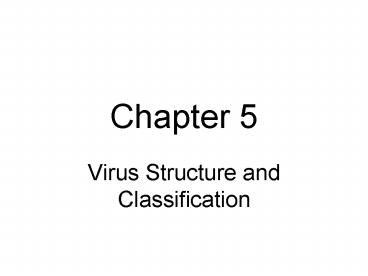Virus Structure and Classification - PowerPoint PPT Presentation
1 / 14
Title:
Virus Structure and Classification
Description:
Visualization is usually with an electron microscope ... icosahedron regular, solid shape that enfolds viral genome. Viral Caspid Structures ... – PowerPoint PPT presentation
Number of Views:1182
Avg rating:3.0/5.0
Title: Virus Structure and Classification
1
Chapter 5
- Virus Structure and Classification
2
VirusStructure
- Visualization is usually with an electron
microscope - Cant see the virus in cells by light microscopy
but can see the effect of virus in cells - enlarged nuclei in tissues
- cytopathic effect in tissue culture
3
Composition of Viruses
- Genome or core RNA or DNA
- Capsid protects genome and is virally encoded
structural proteins - also have other virally encoded proteins that
help in replication - Some viruses have envelopes on the outer virion
surface that have proteins that interact with the
surface of cell that the virus infects
4
Virus Structure
5
Viral Genomes
- RNA or DNA single-stranded or double-stranded
circular or linear - Used to classify viruses
- DNA viruses replicate in host nucleus, share
common patterns as host cell - RNA viruses must have specific enzymes that are
not in cells so can make RNA for new viruses - Viral and cellular proteins are not identical
- Virus encodes enzymes and proteins that modify
the cell in which virus replication
6
(No Transcript)
7
Viral Capsids
- Complex, many identicakl subunits of viral
protein subunit capsomere - Protects viral genome in 2 stable shapes for a
particle of nucleic acid and protein
nucleoprotein - helix capsomere associates with helicalk genome
- icosahedron regular, solid shape that enfolds
viral genome
8
Viral Caspid Structures
9
Capsids have Symmetry
- Capside around the genome is unique for each type
virus - They have symmetry which is a criteria for
classification - Capsid structure is defied by X-ray
crystallography - Capsids have various complexity of structures
based on the viral genome
10
Symmetry
- Icosahedral capsid has 3 distinct symmetry
patterns interactions of one plane to another - 2 fold
- 3 fold
- 5 fold
11
Viral Membrane Envelopes
- Some viruses have a lipid envelope that surrounds
the capsid - Lipid bilayer is from the cell in which the virus
replicates and virally encoded membrane
associated proteins also used to characterize
viruses - Usually is amorphous because shape is defined by
the capsid
12
Classification Scheme
- Based on basic properties of the virus and
specific features of the replication cycle - What type of genome?
- RNA/DNA, ss/ds, circular/linear, single
piece/segmented - How is capsid arranged
- symmetry and dimension
- What other components?
- envelope
- proteins in virion responsible for infection or
maturation
13
Baltimore Scheme
- Used mainly for RNA viruses and based on how mRNA
is synthesized - limited by type of genome in the virus
- sense RNA virus RNA serves as mRNA template
- - sense RNA virus RNA serves as complimentary
sense of mRNA - DNA has both senses
- Retrovirus - sense RNA but use DNA in
replication cycle are not classified - Table 5.1 combination of Baltimore scheme and
criteria listed above
14
Classification by Disease
- Value to medical and public health professionals
- Arthropod-borne arboviruses
- Some viruses can cause similar disease so must do
diagnostic tests to determine etiology (causative
agent) of the disease































